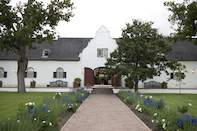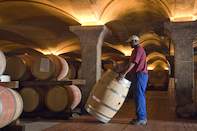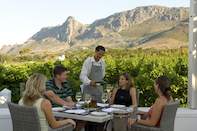More than three centuries ago, wine was being made at Steenberg and weary travellers were offered humble board and lodging. Little has changed, except that today the accommodation, indeed the entire offering, is far from humble.
Stone Mountain

In the early 1700s, the Cape's Dutch colonial authorities decided that sheltered Simon’s Bay, on the False Bay side of the Cape Peninsula, would make a better main harbour for the settlement than storm-buffered Table Bay.
It took two days to travel from Simon's Bay to Cape Town by ox wagon and horse-drawn carriage, and the farm Swaeneweide (swans' feeding place') at the foot of Steenberg ('stone mountain') was exactly halfway.
So the farm’s owner, widow Christina Diemer, started offering board and lodging - and, no doubt, wine with the meal, as it was her late husband Frederik Russouw who made the first wine here.
He had bought the farm from a Cape legend, the indomitable Catharina Ras who, in 1662, had boldly asked Governor Simon der Stel for land in Constantia, the cradle of Cape winemaking.
Physical reminders of the early entrepreneurs can be encountered at the farm today. The 'swans' that inspired Steenberg's original name - probably spur-winged geese or African sacred ibises - still visit the dams, and the 'holbol' gable added by Nicolaas Russouw still adorns the 18th-century manor house, now part of five-star Steenberg Hotel & Spa.
Heritage Re-imagined

Several restored farm buildings today house a range of luxurious farmhouse-styled villas and suites, where furnishings and décor reflecting Western European and Dutch Indian influences on the early Cape Colony have been combined with ultra-modern conveniences; dark antique pieces set amidst bright and snowy white linens and softs.
Buildings are surrounded by greenery: vineyards edged with trees, lawns enclosed by herbaceous borders, with the Wellness Cape Town Spa including outdoor treatments in scented gardens beside secluded pools.
Also part of this layout is the original cellar, stylishly renovated to house what was Catharina’s restaurant, recently re-imagined as Tryn (the feisty Catharina’s nickname).
The eatery’s new, slightly more informal feel offers contemporary cuisine and comfortable furnishings. Bold colour on walls and upholstery (jade, ruby, burnt orange, mustard) are offset against earthy timber and stone finishes.
Much of the development of Steenberg as a high-end residential golf and wine estate was carried out in the 1990s by giant Johannesburg mining house Johnnic. Houses in the modern Cape Dutch vernacular were set beside the fairways of the world-class 18-hole golf course.
A modern winery was built and some 60 hectares of vineyards were replanted with classic varieties by renowned Constantia viticulturist Herman Hanekom.
Since then, Steenberg's cool-climate vineyards have been producing outstanding wines, notably under cellarmaster John Loubser working with subsequent owners leisure and travel group Mantis Collection.
After the late mining magnate and visionary wine property developer Graham Beck bought the winery and hotel in 2005, Loubser, having previously worked at Beck’s Robertson wine farm, expressed his pleasure with the comment, 'It's great to be making wine for a wine man again.'
Loubser, later inducted into the illustrious Cape Winemakers Guild, was followed by JD Pretorius as winemaker (now also a CWG member), succeeded in 2019 by experienced Elunda Basson.
Wine and Art

Fine-tuning by Graham Beck Enterprises has not only included Tryn Restaurant, with its verandah overlooking vineyards, Silvermine Mountain and distant False Bay, but more substantial changes at the tasting area of the cellar, where restyling also involved the bistro overlooking the fermentation cellar.
Bistro Sixteen82 is modern, minimalist, all white and shades of grey, offering indoor and alfresco tapas and Asian-influenced dining. Views through expansive plate-glass windows across Zen-like pools of water with stone mosaics take in green lawns, fragrant indigenous gardens, serried ranks of vines and rocky mountain slopes.
The emphasis on dining speaks of the owners’ understanding of Steenberg wines as accompaniments to food, with their distinctive minerality and classic dry tannins.
Dictated by the lean, granite soils of nearby Stone Mountain, these qualities are most evident in two of the flagship wines: the Catharina red blend and the Magna Carta white blend, which features Steenberg's stand-out Sauvignon Blanc and Sémillon, the focus on the farm together with classic French reds cabernet sauvignon, merlot, malbec and shiraz. Italian red variety nebbiolo, a rarity in South Africa, is a Steenberg specialty.
Collaboration with Graham Beck Winery in Robertson, with its dedicated sparkling wine production cellars, informs the méthode Cap Classique bottlings under their decorative 1682 labels.
As with these, art is everywhere here, from the colourful Cecil Skotnes paintings on Tryn’s walls to the imposing Edoardo Villa sculptures dotted among the vines, curated from the Beck family’s extensive private collection of contemporary works.
 The winelands of Constantia and Durbanville share more than just their conveniently close proximity to Cape Town. Their elegant, fruit-rich ...
The winelands of Constantia and Durbanville share more than just their conveniently close proximity to Cape Town. Their elegant, fruit-rich ...